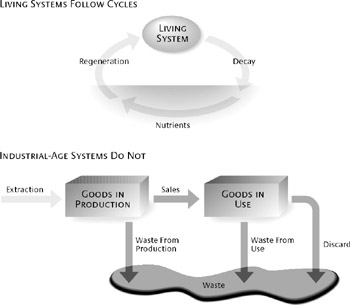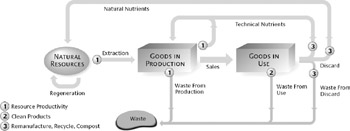Naturalism: Biomimicry and the Logic of Natural Systems
The diverse innovations that created the first Industrial Revolution sprang from the same guiding image that inspired the preceding scientific revolution—the image of the machine. "My aim", wrote seventeenth-century scientist Johannes Kepler, "is to show that the celestial machine is to be likened not to a divine organism but rather to a clockwork".[10] The assembly line became the prototypical organization—with managers as controllers and workers operating in rigid routines, all coordinated by bells, whistles, and production schedules. The assembly line was so successful it became the model for other types of organizations, including the nineteenth-century urban school system. Although the machine-age organization achieved previously unimaginable productivity, it also created a mechanized organizational environment that dehumanized and fragmented how people worked together.
If the machine inspired the industrial age, the image of the living system may inspire a genuine postindustrial age. This is what life-sciences writer Janine Benyus calls "biomimicry", innovation inspired by understanding how living systems work. "What is consistent with life is sustainable", says Benyus. For example, in nature there is no waste. All byproducts of one natural system are nutrients for another. Why should industrial systems be different? We would not ask engineers to build bridges that defy the laws of gravity nor chip designers to violate laws of physics. Why should we expect businesses to violate the law of zero waste?
All living systems follow cycles: produce, recycle, regenerate.
By contrast, industrial-age systems follow a linear flow of extract, produce, sell, use, discard—what "Ecology of Commerce" author Paul Hawken calls "take-makewaste". (See "Why Industry Produces Waste".)
Indeed, the primary output of today's production processes is waste. Across all industries, less than 10% of everything extracted from the earth (by weight) becomes usable products. The remaining 90 to 95 percent becomes waste from production.[11] Moreover, what is sold creates still more waste—from discard and from use (for example, from auto exhaust). So, while businesses obsess over labor and financial capital efficiency, we have created possibly the most inefficient system of production in human history.
What would industrial systems that conform to natural principles look like? First, they would be circular rather than linear, with significant reductions in all waste flows. (See "How Industry Can Reduce Waste".) This implies three specific wastereduction strategies: resource productivity, clean products, and remanufacturing, recycling, and composting".[12]

Figure 19.2: Why Industry Produces Waste
-
Strategy 1. Resource productivity reduces waste from production through ecoefficient production technologies and the design of production processes in which wastes from one process become nutrients for another.
-
Strategy 2. Clean products (say, hybrid cars) reduce waste from goods in use through nonpolluting product technologies.
-
Strategy 3. Remanufacturing and recycling (creating "technical nutrients") and designing more products that are biodegradable (creating "natural nutrients") reduce waste from discard.
Architect William McDonough and chemist Michael Braungart summarize the three strategies with the simple dictum: "Waste equals food".
Second, companies would invest in nature's regenerative processes. They would do fewer things that compromise regeneration, such as paving over wetlands, and would invest some surpluses in restoring natural capital—for example, companies like Interface plant trees to match business miles traveled because increasing forest cover reduces greenhouse gases.
Third, following Buckminster Fuller's dictum, companies would "learn how to live on our energy income [solar, wind, hydrogen] rather than off our principal [oil and gas]". Living on our income would not only reduce resource extraction, but also eliminate the side effects of using minerals, like auto emissions.
Thinking in more systemic terms may appear simple, but it raises important questions about current corporate environmentalism. For example, ecoefficiency has become a goal for companies worldwide, with many realizing significant cost savings from eliminating waste from production. That is good in some ways, but troubling in others. Thinking about the larger system shows that ecoefficiency innovations alone could actually worsen environmental stresses in the future.
Ecoefficiency innovations reduce waste from production, but this does not alter the number of products produced nor the waste generated from their use and discard. Indeed, most companies investing in cost-reducing ecoefficiency improvements are doing so with the aim of increased profits and growth. Moreover, there is no guarantee that increased economic growth from ecoefficiency will come in similarly ecoefficient ways. In today's global capital markets, greater profits show up as investment capital that could easily be reinvested in old-style eco-inefficient industries.

Figure 19.3: How Industry Can Reduce Waste
To put it another way, nature does not care about the industrial system's efficiency. Nature cares about its impact in absolute terms. If a vastly more ecoefficient industrial system grows much larger, it conceivably could generate more total waste and destroy more habitat and species than a smaller, less ecoefficient economy.
The answer is not necessarily zero growth. The implications of naturalism are more subtle: We can sustain growth only by reducing total material throughput and total accumulated waste. Ecoefficiency gains are laudable but dangerously incomplete, as is any strategy that fails to consider the industrial-natural system as a whole. A systemic approach would reduce all sources of waste: from production, use, and discard.
Managers' faith in ecoefficiency also illustrates the power of mental models. Industrial-age managerial practice has always been about increasing efficiency. Increased natural-resource productivity that translates directly into lower costs offers a compelling business case, one that does not challenge established thinking deeply. However, focusing on ecoefficiency may distract companies from pursuing radically different products and business models—changes that require shifts in mental models, not just shifting attention within existing mental models.
This is unlikely to happen without mastering the human dimensions of learning and change.
[10]Boorstin 1985, 108–109.
[11]See Hawken, Lovins, and Lovins (1999), 14, Ayers (1989), Lovins, Lovins, and Hawken (1999).
[12]These three strategies, in concert with ideas below, relate closely to the four strategies of "natural capitalism", three of the four "system conditions" of "the natural step" described in Holmberg and Robert 2000 and McDonough 1992. (The last publication is available through McDonough Braungart Design Chemistry, Charlottesville, Va., by sending a request to info@mbdc.com, or can be downloaded from the World Wide Web at http://www.mcdonough.com/principles.pdf).
EAN: 2147483647
Pages: 214